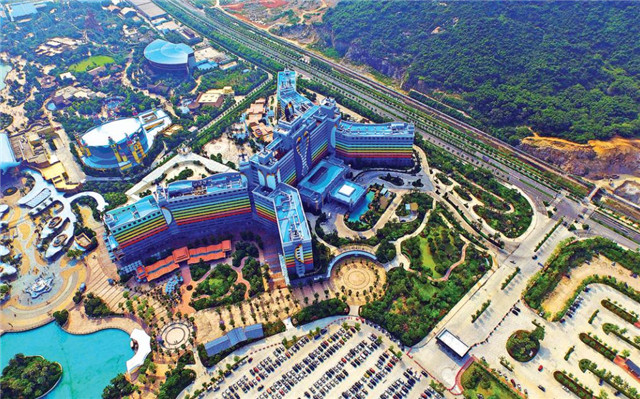
An aerial view of Hengqin Free Trade Zone in Zhuhai, Guangdong province, in 2015. Zhuhai is one of the four special economic zones China established in 1980. [Photo provided to China Daily]
China among countries to learn lessons from Ireland's Shannon economic zone
Shannon, an Irish town with a population of less than 10,000, has over the past three decades attracted several high-ranking Chinese officials.
The town is not known for its beauty or its history but its association with the Shannon Special Economic Zone, which was built on reclaimed marshes next to Shannon Airport.
Established in 1959, Shannon was the world's first free-trade zone and has inspired dozens of countries that want to similarly grow their economies and attract foreign capital through such an area.
When China adopted reform and opening up in 1978, it allow a greater role for the market and foreign investors in the Chinese economy.
Chinese leaders realized that special economic zones could work very well in leading economic development, and looked to Ireland for inspiration.
In 1980, Jiang Zemin, later China's president from 1993 to 2003, was among a group of Chinese officials who embarked on a world tour to see how special economic zones worked elsewhere.
The delegation was introduced to the world's first duty-free shop and a special zone based on low tax and free trade.
The Chinese government subsequently established four special economic zones in 1980 based on the Shannon model. These became a major driving force for China's economy, allowing private investment to flow into the country and a huge transfer of skills and technology to take place.
Shannon's close ties with China and the town's penchant for practical solutions to problems were further illustrated when President Xi Jinping, then vice-president, led a delegation of about 150 Chinese business executives on a visit there in 2012.
During Xi's three-day visit, he attended a traditional banquet at Bunratty Castle, a few kilometers from Shannon.
Its links with China deepened further when Premier Li Keqiang arrived in Shannon for a two-day visit to Ireland before his Latin America trip in 2015.
Kevin Thompstone, president of Shannon Chamber of Commerce, said: "For a lot of Irish, it's hard to understand (why Chinese leaders enjoy visiting Shannon), but it is almost a spiritual connection."
Thompstone said the history of visits paved the way for more in the future.
Patrick Edmond, Shannon group strategy director and managing director of the International Aviation Services Centre at Shannon Airport Authority, said Chinese leaders' visits are not only based on historical elements, but also can be viewed as recognition of where some of the ideas used by China came from.
Edmond, who recently visited Shenzhen, China's first special economic zone, said: "I remember being in Shenzhen in the mid-1990s, and it was a different universe."
He was stunned by the way China had developed its economic zones since the early days, and the way in which they have been a really good tool for opening up creativity and potential.
He said Shannon's geographic position and the fact that it is an interesting gateway make it noteworthy to Chinese leaders.
Shannon was the first airport in the world, outside of the Americas, to offer US preclearance facilities to passengers traveling to the United States. The service allows US-bound passengers to undertake all immigration and customs checks at Shannon, prior to departure.
Enda McLoughlin, mid-west regional manager at Ireland's International Investment and Development Agency, said: "Shannon is a magnet as there is a great sense of growth and tangible opportunities, which mirrors the developing experiences in China."
The region has a high density of a broad range of multinational companies, he added.
McLoughlin said: "The Chinese leaders are also attracted by the high levels of collaboration between the local government, universities and industries, which all promote innovation and the development of the region from an economic and social perspective."
Data
Ireland-China trade has more than doubled since 2013 to an estimated 15 billion euros ($18.4 billion) in 2017.
Foreign direct investment from China into Ireland surged in 2016 to $2.9 billion from just $10 million a year earlier, according to a study by international law firm Baker McKenzie.
Ireland's energy sector also received a boost, with a $400 million investment from China General Nuclear Power's European energy arm, into 14 Irish wind farms owned by Gaelectric.
The big rise in investment was largely down to the HNA Group's purchase of Irish aircraft leasing company Avolon, for $2.5 billion.
More than 5,000 Chinese students are attending Irish educational institutions.
Last year, about 120,000 passengers travelled between Ireland and the Chinese mainland, with journeys to and from Beijing accounting for more than a quarter of those trips.
Tourism Ireland estimates that about 70,000 Chinese visitors came to the island of Ireland last year, up from 60,000 visitors in 2016.

















